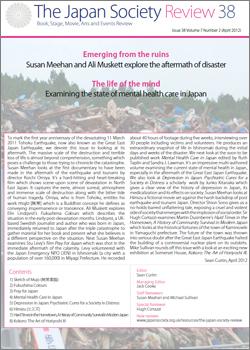Issue 38 (April 2012, Volume 7, Number 2)

To mark the first year anniversary of the devastating 11 March 2011 Tohoku Earthquake, now also known as the Great East Japan Earthquake, we devote this issue to looking at its aftermath. The massive scale of the destruction and terrible loss of life is almost beyond comprehension, something which poses a challenge to those trying to chronicle the catastrophe.
Susan Meehan looks at the first documentary to have been made in the aftermath of the earthquake and tsunami by director Koichi Omiya. It’s a hard-hitting and heart-breaking film which shows scene upon scene of devastation in North East Japan. It captures the eerie, almost surreal, atmosphere and immense scale of destruction along with the bitter tide of human tragedy. Omiya, who is from Tohoku, entitles his work mujo [無常] which is a Buddhist concept he defines as conveying impermanence or transience.
Ali Muskett explores Elin Lindqvist’s Fukushima Colours which describes the situation in the early post-devastation months. Lindqvist, a UK-based Swedish journalist and author who was born in Japan, immediately returned to Japan after the triple catastrophe to gather material for her book and present what she believes is a different perspective on the situation.
Next Susan Meehan examines Stu Levy’s film Pray for Japan which was shot in the immediate aftermath of the calamity. Levy volunteered with the Japan Emergency NPO (JEN) in Ishinomaki (a city with a population of over 160,000) in Miyagi Prefecture. He recorded about 40 hours of footage during five weeks, interviewing over 30 people including victims and volunteers. He produces an extraordinary snapshot of life in Ishinomaki during the initial days and weeks of the disaster.
We next look at the soon to be published work Mental Health Care in Japan edited by Ruth Taplin and Sandra J. Lawman. It’s an impressive multi-authored volume examining the current state of mental health in Japan, especially in the aftermath of the Great East Japan Earthquake.
We also look at Depression in Japan: Psychiatric Cures for a Society in Distress a scholarly work by Junko Kitanaka which gives a clear view of the history of depression in Japan, its medicalization and its effects on society.
Susan Meehan looks at Himizu a fictional movie set against the harsh backdrop of post earthquake and tsunami Japan. Director Shion Sono gives us a no-holds-barred unflattering tale, exposing a cruel and violent side of society that emerges with the implosion of social order.
Sir Hugh Cortazzi examines Martin Dusinberre’s Hard Times in the Hometown, A History of Community Survival in Modern Japan which looks at the historical fortunes of the town of Kaminoseki in Yamaguchi prefecture. The future of the town was thrown into serious doubt after the Great East Japan Earthquake halted the building of a controversial nuclear plant on its outskirts.
Mike Sullivan rounds off this issue with a look at an exciting new exhibition at Somerset House, Kokoro: The Art of Horiyoshi III.
Contents
- Sketch of Mujo (無常素描)
- Fukushima Colours
- Pray for Japan
- Mental Health Care in Japan
- Depression in Japan: Psychiatric Cures for a Society in Distress
- Himizu [ヒミズ]
- Hard Times in the Hometown, A History of Community Survival in Modern Japan
- Kokoro: The Art of Horiyoshi III
Contributors
Editor
Sean Curtin
Managing Editor
Jack Cooke
Staff Reviewers
Susan Meehan and Michael Sullivan
Reviewers
Ali Muskett, Sandra Lawman, Sean Curtin and Sir Hugh Cortazzi

